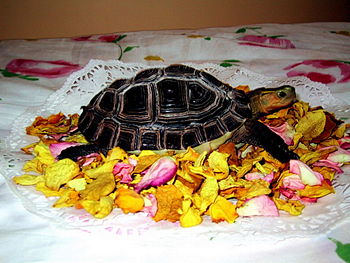Chinese box turtle: Difference between revisions
imported>Caesar Schinas m (Bot: Update image code) |
imported>John Stephenson (some copyediting) |
||
| Line 1: | Line 1: | ||
{{subpages}} | {{subpages}} | ||
{{Image|ChineseBoxTurtle.jpg|right|350px|Chinese box turtle.}} | |||
The '''Chinese box turtle''' (''Cuora flavomarginata''; also known as the Yellow-margined Box Turtle, Snake-eating turtle, Yellow-margined box turtle, and Golden-headed turtle) is one of the [[species]] of [[Asian box turtle]]. | |||
Its [[Latin language|Latin]] names are ''Cistoclemmys flavomarginata'' (by John Edward Gray, 1863), ''Cuora flavomarginata'', and ''Cyclemys flavomarginata''. | |||
Latin | |||
== Taxonomy == | == Taxonomy == | ||
Fauna -> Chordata -> Vertebrata -> Reptilia -> Testudinata -> Cryptodira -> Emydidae -> Batagurinae -> Cistoclemmys -> Cistoclemmys flavomarginata | Fauna -> Chordata -> Vertebrata -> Reptilia -> Testudinata -> Cryptodira -> Emydidae -> Batagurinae -> Cistoclemmys -> Cistoclemmys flavomarginata | ||
There is a debate about whether the Chinese box turtle should belong to Cuora or Cistoclemmys. Some people suggest moving it from the former to the latter due to its highly terrestrial habit. But since the usage of both Cuora and Cistoclemmys has some standing, there is no final classification yet. | |||
== Range and natural habitat == | == Range and natural habitat == | ||
Chinese box turtle | The Chinese box turtle lives in several provinces of southern China such as Hunan, Henan, Anhui, Hubei, Chongqing, eastern Sichuan, Zhejiang and Jiangsu. It is also found in Taiwan and the Ryukyu Islands of Japan. | ||
They prefer to the banks of mountain streams and shallow, still water in sub-tropical climates. | They prefer to the banks of mountain streams and shallow, still water in sub-tropical climates. | ||
| Line 25: | Line 23: | ||
== Ecology == | == Ecology == | ||
Chinese box turtle is omnivorous. They will eat snails, slugs, mealworms, earthworms and | The Chinese box turtle is omnivorous. They will eat snails, slugs, mealworms, earthworms and fish. Some fruits and veggetables like watermelons, strawberries, bananas, tomatoes. Also eggs and cakes. | ||
Latest revision as of 09:10, 27 December 2020
The Chinese box turtle (Cuora flavomarginata; also known as the Yellow-margined Box Turtle, Snake-eating turtle, Yellow-margined box turtle, and Golden-headed turtle) is one of the species of Asian box turtle.
Its Latin names are Cistoclemmys flavomarginata (by John Edward Gray, 1863), Cuora flavomarginata, and Cyclemys flavomarginata.
Taxonomy
Fauna -> Chordata -> Vertebrata -> Reptilia -> Testudinata -> Cryptodira -> Emydidae -> Batagurinae -> Cistoclemmys -> Cistoclemmys flavomarginata
There is a debate about whether the Chinese box turtle should belong to Cuora or Cistoclemmys. Some people suggest moving it from the former to the latter due to its highly terrestrial habit. But since the usage of both Cuora and Cistoclemmys has some standing, there is no final classification yet.
Range and natural habitat
The Chinese box turtle lives in several provinces of southern China such as Hunan, Henan, Anhui, Hubei, Chongqing, eastern Sichuan, Zhejiang and Jiangsu. It is also found in Taiwan and the Ryukyu Islands of Japan.
They prefer to the banks of mountain streams and shallow, still water in sub-tropical climates.
Identification
Chinese box turtle has a dark brown, high arched carapace with a light stripe on keels. The stripe may fade with age. The underside of the marginal scute is yellow. The top of its head is olive and the sides are light orange with a yellow horizontal strip behind its each eyes.
The name box turtle refers to Chinese box turtle's ability to bring the plastron to the edges of the carapace when in danger, which makes it look like a closed box.
Males have a broader tail and a narrower carapace than females.
Ecology
The Chinese box turtle is omnivorous. They will eat snails, slugs, mealworms, earthworms and fish. Some fruits and veggetables like watermelons, strawberries, bananas, tomatoes. Also eggs and cakes.
